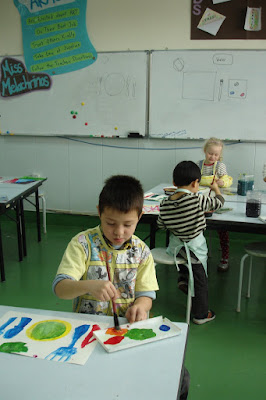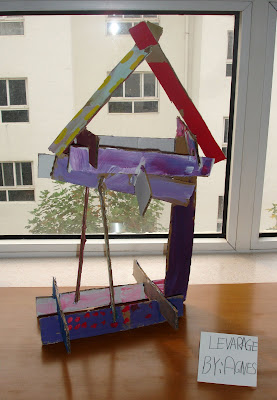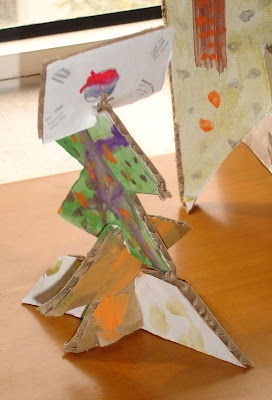This morning, my principal asked about my work load.
Is is too much? You're teaching PreK-5th grade.I found the question quite timely. Just last night, I told my mom that I'll never be able to teach in the States.
What are you trying to tell me? she asked.
I reassured her that these almost two months had not turned me into a life-er, as they're called. For now, I'm here, and since I'm here, my energy is focused on here. Decisions about my life after June 2010 will come later.
But this is what I was saying...
I am SO SPOILED (or spoilt, as the Brits would spell it).
Let me reiterate, if you don't remember, my "full load" involves teaching 13 classes a week. Those 13 classes, each has a class size of 7-15 students! On top of all of this, Mrs. Greene and I work with the art teaching assistant, a local Chinese woman who has been at the school for 4 years. She is in the classroom for most of my classes, providing another set of adult hands, along with helping purchase and prep materials.
Yesterday, I painted with 9 first grade students during the last period of the day. We had about 15 minutes between classes. It was just enough time for me and Mrs. Yang to set up 9 painting stations, fully equiped with water, paper towels, two paintbrushes, a 15x20 sheet of paper, and a palette with
red, yellow, blue, and white paint.Side note: My students were so excited to paint this week that one student brought paintbrushes from home! Waiting to come into the room in the hallway outside the classroom, another student commented
"but she only has 7 paintbrushes!" I assured him that I had paintbrushes too, and every student would get a paintbrush, even if she didn't have enough for everyone in class...
At the end of class, I took the students to the bathroom next to my classroom to wash hands. (My classroom sink isn't classroom friendly.) When I came back to the classroom,
clean-up was well underway.Paintings were on the drying rack.
Tables were wiped down.
Water buckets were rinsed out and drying.
Palettes and brushes were collected, and she was cleaning them all in the classroom sink.
At the end of the day, I painted with an entire class of 1st graders, all class period, and did not wash out a SINGLE paintbrush.Painting is typically a labourous undertaking for an art teacher.
It's quite easy at my school. Mrs. Yang and I, we have it covered.
I am so thankful, and my students will truly reap the rewards. They LOVE painting!
Today, I painted with 7 PreK students. It was the second week in a row of painting for them. You should see the learning! Given limited paint options (teacher-planned, of course), they make such discoveries...
Last week, each student had one cup of paint---the color of the table where they sit. Then, they worked with a friend from another table with a different primary color. I moved their seats around so we had one red-yellow pairing, one yellow-blue pairing, and one blue-red pairing. (One student was absent, so we had six students exactly.) Each group had one long sheet of paper. They took turns making dots on the paper in a line. As their classroom teacher told me, they were working on basic sequencing. Every other made a nice alternating pattern along the paper.
Next, I gave each pair a palette. Each person was supposed to put some of their color on the palette, then
MIX IT TOGETHER!Nevermind the fact that their classroom teacher had already taught them about green, orange, and purple. They even predicted what color would happen when each combination was mixed, still, actually mixing the colors on their palette...
IT WAS MAGIC.You should have been there. There's no way to put into words the excitement of a four year old when they first mix together blue and yellow and see that
it really does make green!They were blown away. For the remainder of the class, each student painted their own 15x20 sheet of paper using their color and the color of their friend. We had trains, flowers, faces, birds, and a student who just covered the entire surface, systematically, from corner to corner, with yellow-orange paint. The great thing is, the large sized paintbrushes combined with their developing fine motor skills meant that most of the objects just looked like blobs of paint! But they were trains and flowers, faces and birds.
This week, I wanted to build on those experiences. I knew their teacher recently introduced them to the color white. This would allow for new mixing opportunities...
When the students came into class, their places were all ready except for paintbrushes. This was my attempt to stop them from painting until I gave my intro.
It didn't work. Two students just put their hands directly into the palette of white paint.
After brief encounters with paper towels, we were ready to get started.
What color is your paint today. White! And what color is your paper? White! Oh no. How is that going to work? White paint on white paper? What should we do? We need another color! Good idea! Everyone can pick ONE color to add to their palette.
Last week, we mixed colors with our friends. What will happen if we mix our color and white?
No one knew, so we needed to try it!
Another amazing moment, as students around the room found light blue, light yellow, and pink. Gasps, literally gasps, and huge smiles.
So adding white makes a color lighter...
And pink, as I explained, is a special name we use to talk about light red.
My intention was to have them paint with those two colors---white and the color they chose. One student requested another color. I decided two primaries and white would be fine. There's no chance of all-brown paintings with just two primaries.
I let each student pick a second primary color. The color mixing that ensued was so fun! Look for some PreK paintings to be posted in the future...
I was thinking tonight, at this point in time, seven years ago, I wanted to be a preschool teacher. I was just starting high school and wasn't serious about art. I didn't sign up for Art 1, only the ceramics elective.
I still love teaching PreK. I am so glad their class got added to my workload. But I love the other grades too. Surprisingly, I even loved my high schoolers at Fleetwood and my middleschool and highschoolers at Stoke Damerel. I hope to have more interaction with secondary students at our school as time goes on and the program develops.
I love kids of all ages, and I love teaching. But teaching art is definitely a blast! I wouldn't want to trade it for any other subject...
just look at the faces of my first graders as they line up outside of the art room, eager to come in and start painting! I see the other first grade class tomorrow afternoon. I can't wait to see their excitement!















































